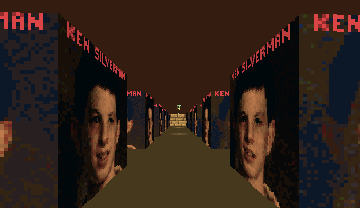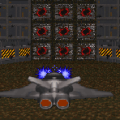
Front Cover
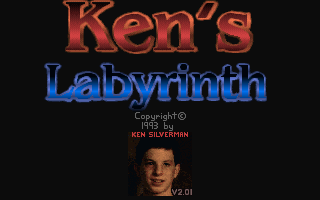
In its prime, the Build engine was considered nothing short of a technical marvel. While it took some time for developers to realize its true potential, the wait produced nothing short of amazement. The engine programmer Ken Silverman brought forth allowed for games with enough detail to replicate real world locations, larger-than-life characters reacted dynamically to the action around them, and the weapons that only got wilder with every game. Games like Duke Nukem 3D didn’t spawn in a void, however. While Ken’s Labyrinth itself doesn’t use the Build engine, many of its innovations would be brought into the classics of the genre that did. As the true father of Lo Wang, Caleb, and Duke as we know him now, Ken’s Labyrinth is a weird, wacky game that still deserves examination for sheer oddness alone.
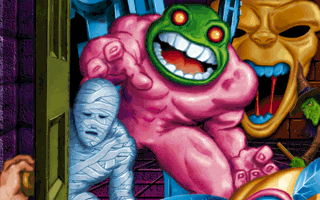
Just a small number of the things you can expect to run into.
Your faceless player character and their dog Sparky have been kidnapped by aliens and placed in a massive labyrinth deep in their homeworld. Using the maze as a test of your intelligence and thus, the worth of the human race, failure will apparently lead to the people of Earth being turned into coal. Which naturally, the aliens will use to fuel the stoves that make the jelly they use for their breakfast. Over the course of three episodes, it’s up to you to find your missing dog, find a safe hiding spot for him, and then find a way to escape back to Earth. Of course, you’ll also have to find and defeat Ken, the ruler of the alien empire, in the sort of naming you could still get away with in 1993.
The game’s strangeness is perhaps best exemplified by its very beginning. Much like many early shooters, you start off in a small room with no enemies to attack you, giving you a chance to learn the controls and how to move in a first person perspective. Your first weapon won’t be something as ordinary as a gun, a knife, or even your bare fists, however. No, your first weapon appears to be a giant blob of jelly dangling on a hook. Not only that, your captors have provided you with a water fountain, a small tree, a room full of pictures of the continent of North America helpfully labeled ‘United States’, and a cheerfully written ‘Welcome’ sign. It’s a very strange first impression, and an accurate sign of things to come.
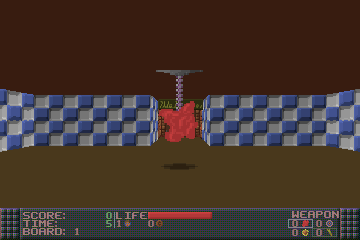
The very basic gameplay doesn’t too fall far from Wolfenstein 3D, which in fairness, was more or less the only thing of the time to base an FPS on. Each of the 30 levels tasks you with wandering a maze, destroying every monster in sight, collecting keys, unlocking doors, and finally making your way to the stairs that’ll take you to the next level. With no automap to fall back on, a lot of your time in each level will be spent wandering the maze, keeping an eye out for any doors or keys you may have missed. While occasionally you’ll find a wall texture with a full map of the current level, these are unfortunately less then helpful, given the game’s low resolution. While you’re wandering, however, you’ll have dozens upon dozens of monsters to blast through.
Each of the three weapon types you can find and fire, including the jelly blob you start out with, have unlimited ammunition. Unlike Wolfenstein, both you and the enemies you’ll encounter have visible projectiles that have to hit their target to deal damage. While this means you can strafe to dodge enemy fire, many of the monster types often slide just out of the way of your shots as well, often shooting back quickly enough that avoiding damage is difficult. Your projectiles also don’t begin with much reach, forcing you to get uncomfortably close to monsters to take them out. This is doubly dangerous because any contact with monsters will quickly drain your health. There will often be points where a monster will sneak up from behind and walk into you, taking out a chunk of your health before you can break away.
Compared to Wolfenstein, where you’d find the biggest, baddest gun early on, your climb in power level tends to vary depending on how good you are at finding the secret areas. If you’re especially observant, you’ll quickly find enough powerups to make the game far easier, enough to reach gamebreaking levels. Besides the jelly, you’ll also find starbursts that bounce off of walls and missiles that seek out enemies. Collecting multiple types of the same weapon will permanently increase its fire rate, while finding lightning will do the same for the range of all weapons. Without keeping a careful eye out for all these pickups, you’ll have a somewhat harder time of taking out enemies, although generally not by too much.
If only every secret passage was this obvious.
There’s also several temporary powerups you can encounter. The potions and cloaks you’ll encounter give you benefits like reflecting enemy shots, let your own shots pass through hidden walls, let you kill enemies on touch, or grant invincibility. While all these only last for a short time, picking up more will make the durations stack, so if you’re fast, you can give yourself more than enough time to make short work of potentially tough encounters. Extra lives are some of the rarest powerups, and since you start the game with two lives, they’re something you’ll want to really dig around the levels for. At least, they would be if you didn’t have the ability to save your game at any point.
One particular innovation of the game is the aspect of money. You’ll often find coins and diamonds scattered around the levels, either in piles or hidden in safes. While the game doesn’t give you a lot of money early on, the further you play, the more generous it gets, until you often have more than enough for what you want. You’ll generally use money for toll doors and the occasional vending machine you’ll find, which offers a selection of every powerup in the game. If you’ve got the cash to spare, it’s possible to buy up a bunch of potions and cloak and give yourself plenty of time where enemies can’t hurt you at all, which is more than a little unfair. Sometimes you’ll also stumble on slot machines, and if you’re patient, you can save and load your game until you’ve got exactly the amount of coins that you want.
One thing that Ken’s Labyrinth does that Wolfenstein couldn’t is a far greater amount of interactivity, a small sample of the sorts of things its engine could truly do. You’ll find walls that demand you shoot or walk through them, as well as hidden walls that aren’t quite so obvious. More dangerous are constantly rotating fans and holes that prove fatal to both you and your enemies alike, which can sometimes be useful for thinning out hordes. Water fountains restore lost health at an incredibly slow rate, inspiring a similar concept in Duke 3D. Finally, some objects are just there for no particular reason, like an upright trampoline that reflects whatever you shoot into it directly into your face.
Speaking of your face, this is apparently you. Terrifying.
Generally, most of the enemies you encounter will make a beeline straight for you, often shooting projectiles towards you on the way there. The most dangerous foes can fire off several in short succession while taking multiple hits. In the cramped corridors you’ll often find yourself in, these make for the toughest fights of all, and the point where you’ll most often want to resort to the various tricks you can pull. Not all enemies are quite so straightforward, however – giant eightballs are practically invulnerable unless there’s a hole in their way, while living holes scuttle around, threatening to go right under your feet. Unless, of course, you lead them into a regular hole, which in defiance of all common sense and physics, kills them instantly.
One particularly interesting twist is the entirety of the second episode, in which you’re reunited with your missing weiner dog, Sparky. (Sparky himself isn’t based on a real dog, but rather a wooden model in Ken’s home that a member of Epic noticed.) This adds a new challenge of having to have Sparky following with you when you reach the stairs, or else the game will make you backtrack to go fetch him. While he’s more than fast enough to keep up with you, there are points where he’ll get stuck on an obstacle, which means you’ll need to spend the occasional moment making sure he’s still following. While Sparky will block any and all attacks with nothing more than a bark, this also means that there are often times when he’ll get in the way of your shots, making a hectic situation all the tougher. It’s certainly a unique twist on the genre, and one that could have been done far worse, but by the time you part ways with him for the third episode, you won’t miss his absence too much.
A good boy. Not a very useful boy, but a good boy nonetheless. Unfortunately, he cannot be pet.
Once you’ve gotten used to the strangeness on offer, however, it makes for a pretty basic shooter. Weird or not, wandering around mazes starts to get a little tiring, and once you start gathering enough weaponry, the game loses a lot of its initial challenge. You can’t ever get entirely careless, at least since any enemy is capable of walking into you if you’re not paying attention. Eventually, however, you’ll hit the point where you’ll have powerups that last for ages — especially since the game has a bug where any active powerups when you’re moving to a new episode will have their durations extended for an incredibly long duration. When this happens, you’re left with a situation where you’re left without much to do but wander around the mazes, since the enemies will no longer pose much of a threat to you. Starting each episode fresh will resolve this, but will mean you’ll have to build yourself back up all over again.
There aren’t any powerups that’ll save you from a mean trap like this, though.
What really makes the game stand out, however, is a sense of sincere goofiness that comes from a majority of development coming from a singular person. The whole production has a certain ‘homemade’ feel to it, which is what really helps it stand out against its inspiration. Ken’s very own voice will sometimes chime in with comments like “Ouch!” or “Nice job!”. Every so often, you’ll find pictures of the man himself used as textures, which will cause slight damage if you shoot them. And then there are the buttons that raise or lower the camera, which do absolutely nothing useful, but like so many elements of the game, are there just because they could be. There’s a real sense that things were added not for what would please the publisher or to differentiate the game from Wolfenstein, but just because this is Ken’s game, he made it, and he’ll do whatever he damn well pleases.
To paraphrase Jackie Chan, “I’m Ken Silverman. This is MY game.”
At this early point in the engine, the graphics aren’t too far beyond what Wolfenstein had to offer, with all walls and ceilings left untextured at all times. While there’s a pretty wide variety of enemies to fight, they’re generally rather goofy looking, and only have a handful of frames each. Enemies vanish entirely when killed, making for a rare exception in the ultraviolence that would soon become such a large part of the genre. The sound effects have a similarly ‘homemade’ feel as the rest of the game, with a few effects, like explosions, sounding like they came directly from somebody’s mouth. The music is incredibly difficult to describe, with only fragments like ‘infomercial-like’ coming to mind. It’s usually upbeat, if fairly slow in tempo, but loops so quickly that it soon grows somewhat obnoxious.
This doesn’t help very much.
Overall, if you could tolerate Wolfenstein 3D’s mazey levels and somewhat repetitive gameplay loop, there’s no reason not to dip into Ken’s challenge. It’s true that not everybody will be able to handle much of the game’s unique style, nor will they likely describe the game in such charitable terms. While it may certainly lack the polish or the satisfaction of Nazi death that Wolfenstein offered, Ken’s Labyrinth offers up so much creativity and odd charm that it still manages to offer something on its own. The engine it runs on, however, hardly needs an epilogue, and if you look just closely enough, you might just see the DNA that this game carried forth.
The version most commonly available for download is version 2.1, the full version of what was polished up and published by Epic MegaGames. Version 1.1, a version released under Ken’s brother Alan’s company, can also be found on Ken’s website. There’s an almost uncountable number of differences between the two versions. In short, however, 1.1 is far rougher, lacking a lot of art assets. Demoscene artist and member of notable group Future Crew Mikko Iho greatly polished up a lot of the texture and sprite art, and their work makes a noticeable difference in their look.
This version also lacking mechanics like the shop menu or Sparky the dog, and is far more difficult on the whole. For one thing, this version gives you only one life — lose it and you’re kicked back to the title screen. 1.1 also isn’t split into episodes, with all twenty-seven levels being one continuous run. At the end, you don’t face “Ken”, but rather “King Xenhai”, a Grim Reaper-esque figure. The most amusing part are the extra voice clips that 2.1 lacks — shoot a target and Ken will comment “Nice shot! Too bad it doesn’t count.” while a voice that might be his mother tells you to “Watch where you shoot that thing!”
Version 1.1
Ken’s website also features several ports of the game, including a highly recommended port for Windows and Linux, and of all things, a fan port to the Nintendo Switch.
A fanmade sequel running on GZDoom, a highly enhanced source port of ID Software’s Doom, is currently in development. While Ken Silverman isn’t involved with the project, having long since left game development, he has offered his blessing. An engine that’s known and beloved by so many talented creators mixed with the game’s weird, ‘throw everything at the wall, do whatever’ design could result in something truly special, once it releases.
An in-development screenshot of Ken’s Labyrinth II
Links

